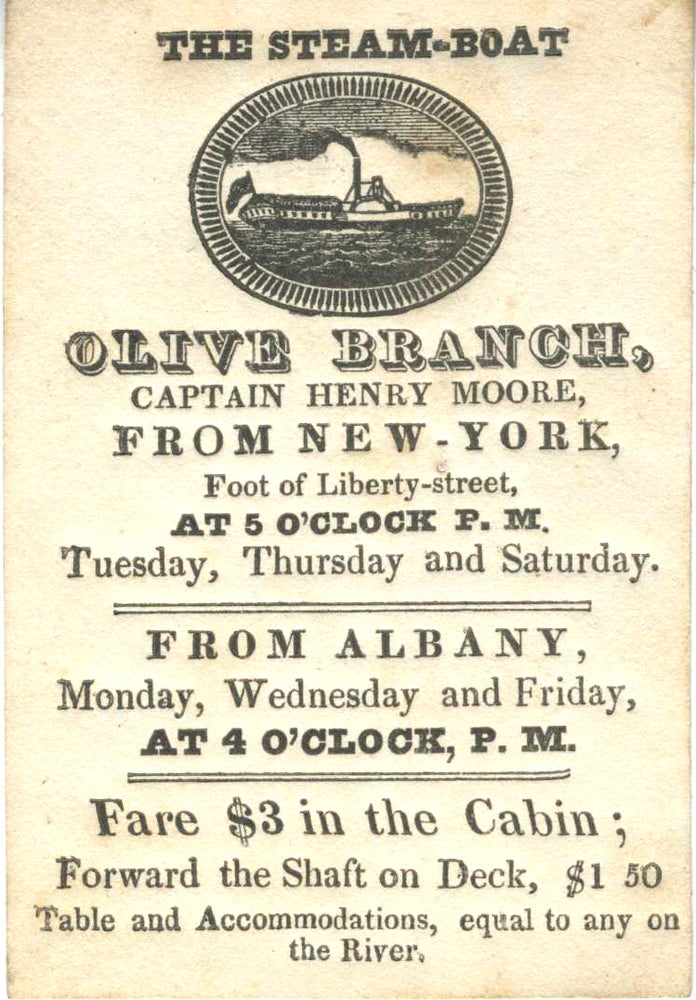Olive Branch - Trade Card.
Ca. 1825. A remarkable trade card for the Hudson River steamboat that was the key to breaking the monopoly of Robert Fulton, Jr. & Robert R. Livingston on Hudson River navigation.
The birth of the Hudson River steamboat trade and the story of its' creators efforts to maintain their monopoly is a long and varied tale. Fulton, the first successful operator of a commercial steam boat in America & his partner/uncle-in-law, Robert R. Livingston (The Chancellor), were granted exclusivity to ply the Hudson River route in 1808. NY State granted these contracts as a way of developing infrastructure, which they did not fund as a state at that point. For each boat put on the Hudson, Fulton/Livingston were granted another 5 year exclusive contract, up to 30 years.
Their monopoly lead unsurprisingly to monopolistic pricing. In 1811, a court challenge to their exclusive deal was brought and Chancery Court judge John Lansing, Jr., broke the monopoly. This was complicated by the fact that Judge Lansing was related to Robert Livingston (his grandson, Edward Livingston (1796-1842) married Lansing's daughter, Sara Ray Lansing (1797-1831.) A year later, a successful appeal to the Supreme Court of the State of New York allowed Livingston and Fulton to maintain their highly profitable monopoly over the water ways of New York. Lansing disappeared under mysterious circumstances in 1829. (He had financial difficulties and had also reported corruption and inefficiency in the Chancery Court to the Governor, so it seems there were plenty of other enemies besides his relatives.)
Robert Robert Livingston IV (1746-1813), was a Founding Father of the United States, First Chancellor of NY and swore Washington in as President on his bible, as well as helping to write the Declaration of Independence. In 1801, he was in France negotiating with Napoleon to buy the Louisiana Purchase. Robert Fulton was also there, and the two designed and launched a steamboat in the Seine. It sank, but their relationship continued. Fulton went to England -akin to switching sides in the times of French/English wars. He had a steam engine built by Boulton & Watts, the inventors of same, and that became the engine of the "Clermont", named after the home of Robert R. Livingston on the Hudson River. When Robert R. died in 1813, he passed his share of the steamboat business to the husbands of his two daughters, Elizabeth (1780-1829) and Margaret Maria (1783-1818). Both daughters married Livingston relations, Elizabeth marrying Edward Philip Livingston (1779-1843) and Margaret marrying Robert L. Livingston 1775-1843).
Robert R's younger brother was John R. Livingston, who is largely described as a merchant during the Revolutionary War after a short stint as a soldier, and it is implied that he had shady deals in his past. (See Clermont State Historic Site, http://clermontstatehistoricsite.blogspot.com/2016/05/was-john-r-livingston-murderer.html)
John R. also aspired to participate in the wealth of the steamboat trade. In 1808, he purchased a license to trade between New Jersey and Staten Island, but not to conduct trade on the Hudson River. Sometime after it was built in 1816, he purchased the Olive Branch from the North River Steamboat Co.
In 1817, there were only 17 ships on the Hudson River. By 1820, there were 69 boats and competition was becoming fierce. Although John R. and many others tried to break the monopoly on the Hudson, it was continuously affirmed by NY State courts until it was weakened in 1824 by the US Supreme Court decision in Gibbons v. Ogden, which supported the regulation of interstate commerce by the Federal government. There were ongoing cases in the Court of Errors in Albany. In June 1824, the case of the North River Steamboat Co. vs. John R. Livingston was heard, but the monopoly was finally broken with the appeal decision (Feb 28, 1825, North River Steamboat Co. (appellant) v. John R. Livingston (respondent).
So, the Olive Branch was the instrument of destruction of the monopoly on the Hudson that had run almost continuously from 1808 to 1824.
The Olive Branch successfully plied the route from NYC to Troy until 1826, when she was abandoned. This original hand-typeset trade card, issued between 1823 and 1827, is momentously important to enforcing the Federal power of interstate commerce. Pre-1830 trade cards are excessively rare in the trade and in collections.
2 1/2 x 3 5/8". Black type on cream card stock, with an engaging image of a steamboat surrounded by an oval notched border. "The Steam-Boat OLIVE BRANCH, Captain Henry Moore, From New - York, Foot of Liberty-street, at 5 o'clock P.M. Tuesday, Thursday and Saturday. From Albany, Monday Wednesday and Friday, at 4 o'clock, P.M. Fare $3 in the Cabin; Forward the Shaft on Deck, $1 50 Table and Accommodations, equal to any on the River." On the verso, in a later but early hand "Built for and owned By Robt. Montg. Livingston" (an incorrect comment.) A trace of foxing but in very good condition.
A great rarity, of great historic importance to the Hudson River. Item #22837
Sold



